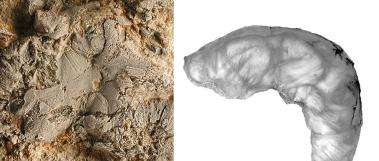Oldest fossil shrimp preserved with muscles

(PhysOrg.com) -- One of America’s favorite seafood is shrimp. Did you know that they fossilize as well? Rodney Feldmann and Carrie Schweitzer (both Kent State University) report on the oldest fossil shrimp known to date. The creature in stone is as much as 360 million years old and was found in Oklahoma. Even the muscles of the fossil are preserved. The study will be published soon in Journal of Crustacean Biology.
“The oldest known shrimp prior to this discovery came from Madagascar,” Feldmann says. This one is way younger, having an age of ‘only’ 245 million years making the shrimp from Oklahoma 125 million years older. The fossil shrimp, having a length of about 3 inches, was found by fellow-paleontologist Royal Mapes (Ohio University) and his students. Feldmann and Schweitzer named the fossil after him: Aciculopoda mapesi.
The discovery is also one of the two oldest decapods (‘ten footed’) to which shrimp, crabs, and lobsters belong. The other decapod, Palaeopalaemon newberryi, is of similar age and was found in Ohio and Iowa. “The shrimp from Oklahoma might, thus, be the oldest decapod on earth,” Feldmann explains.
The fossil is a very important step in unraveling the evolution of decapods. However, more finds are necessary. “The common ancestor of the two species can probably be found in rocks that once formed the old continent Laurasia,” Schweitzer mentions. Nowadays, these rocks can be found primarily in North America and Greenland. Who’s going to find it? Possibly by one of the numerous amateur collectors, who often graciously donate specimens to science.

The description of the fossil is not only remarkable because of its age, but also due to its preservation. In this case, the muscles that once made up the tail part of the shrimp were preserved. This is extremely rare in fossils. Feldmann knows why the muscles are still visible: “When the animal died, it came to rest on the seafloor. The muscles then were preserved by a combination of acidic waters and a low oxygen content as the animal was buried rapidly.”
The shrimp lived in deeper waters of the ocean where currents were too weak to destroy the shrimp. Other animals that were found in the same rock include the extinct ammonites, nautiloids, brachiopods, and sponges.
Provided by Kent State University


















